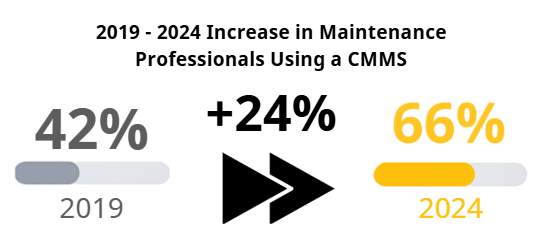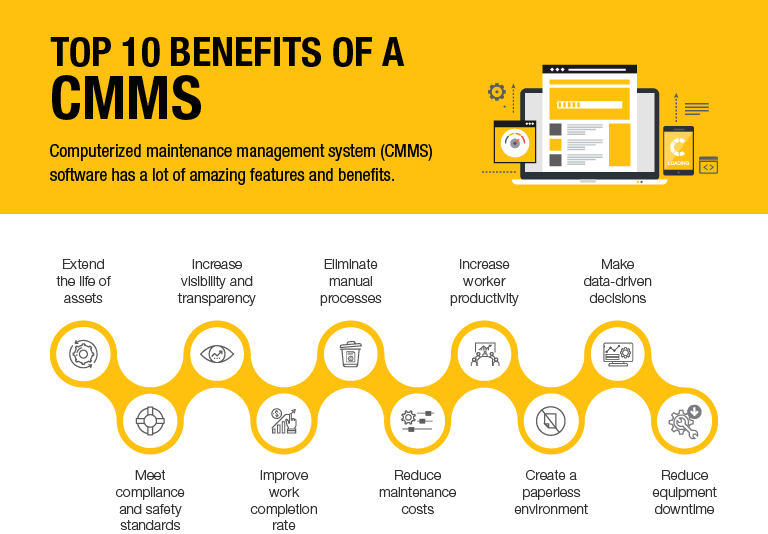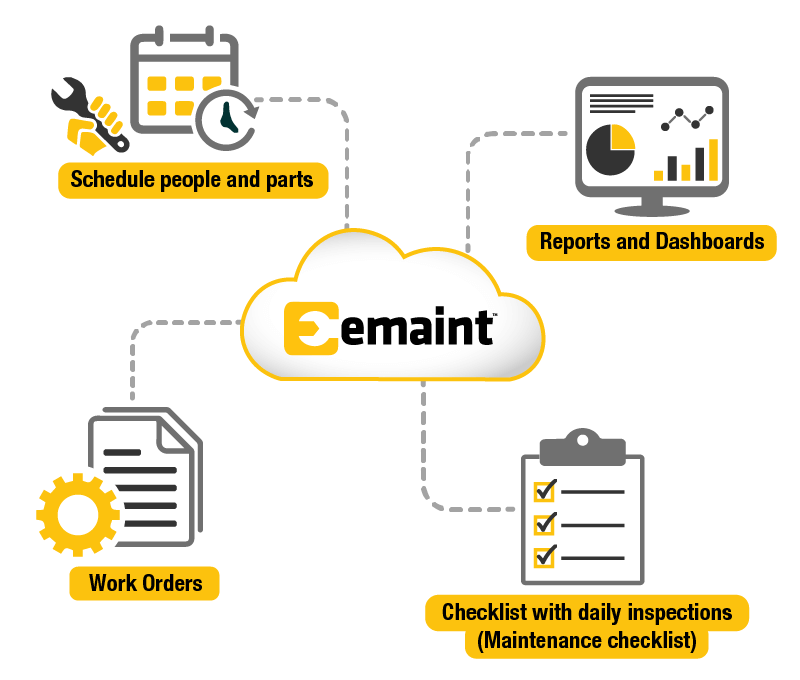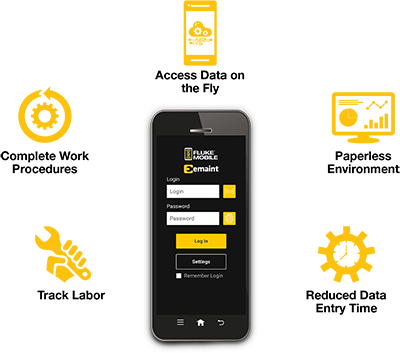By Michael Mills, Technical Solutions Manager at Fluke Reliability • Updated: January 2, 2026 • Originally Posted: 2021 • 10 min read
A CMMS is key to your maintenance strategy in 2026, a time when global economic uncertainty and supply chain issues make defeating downtime more important than ever. A quick glance at the boom in usage of a CMMS in maintenance professionals demonstrates the value of this software:

Warum CMMS-Software verwenden
A CMMS saves time, boosts efficiency, cuts costs, and teams you the power to standardize wins in uptime globally — serving as the central command center for maintenance teams in 2026.
A CMMS that is built by maintenance experts, for maintenance teams, delivers a powerful return on investment (ROI). Custom preventive maintenance checklists? Check. Audit trail optimized for 21 CFR Part 11 compliance? Built-in. Mobile app that empowers offline work? Ready to go. Not to mention the seamless integration of maintenance data with condition monitoring, SCADA, and ERPs.
Global maintenance leaders are using maintenance software every day to achieve results like 95% uptime or $1 million in cost savings, making it clear that teams can only go so far without a CMMS / EAM solution.
Vorteile von CMMS-Software
| Nutzen Sie | Beschreibung |
|---|---|
| Betriebszeit erhöhen | Teams can react to machine failures in real-time with a CMMS solution in the short term. And in the long-term, careful maintenance planning leads to sustained uptime and reliability. |
| Kosten reduzieren | How much does a team waste in maintenance, inventory, and labor costs? CMMS reporting can identify waste - saving teams millions. |
| Maximieren Sie die Effizienz | A CMMS system increases efficiency with real-time work order management. Personnel can quickly find assets or parts and schedule preventive maintenance, so the team is free to do the work that matters. |
| Daten zentralisieren | A CMMS is a source of truth for maintenance, giving the power to report on KPIs like work order completion, mean time between failures (MTBF), multi-site inventory levels, and much more. |
| Mobile Workforce Management | Going mobile is the power of the modern CMMS: mobile maintenance management empowers techs to work in the field and offline, maximizing data entry quality. Mobile CMMS apps save techs an average of 44 minutes per day. |
| Gesundheit, Sicherheit, Compliance | A CMMS simplifies regulatory compliance: audit trails, SOPs, compliant workflows, and set-and-forget dashboards. Proper maintenance also ensures health, safety, and quality, along with sustainability and energy savings. |
| Automatisierung | Automation saves time, reduces human error, and increases efficiency. With a CMMS solution, teams can automate everything from inventory reorders to work order assignments and compliance reports. |
| Verbesserte Sichtbarkeit und Zuverlässigkeit von Anlagen | A CMMS system allows teams to track and manage asset health and lifecycle from pre-installation planning and engineering to decommissioning. This enables smarter maintenance planning. |
| Standardisierung und Konsolidierung | Maintenance standardization — from best practices to data formats — is incredibly challenging. A CMMS helps consolidate maintenance management across a global workforce. |

Testen Sie ein CMMS kostenlos
Sind Sie bereit, ein CMMS-Programm selbst auszuprobieren? Werfen Sie einen Blick auf die folgenden interaktiven Rundgänge, um eine kostenlose Tour durch eine CMMS-Software zu machen.
Wie funktioniert CMMS-Software?
A CMMS software works by collecting and organizing maintenance data into a single, centralized database for your teams. Maintenance teams give the CMMS work order, equipment, and parts inventory data, and the software serves as a maintenance and asset management hub.
A CMMS database is founded on a Relational Database Management System (RDBMS) like SQL. Data is organized into normalized tables. It’s composed of workflows, asset hierarchies, schema templates, preventive maintenance logic, and more that comes together into seamless system.
Understanding CMMS solutions is easier by breaking them into four basic parts:
- An operator interface by which you navigate the data
- A database, typically cloud-based these days
- Administrative settings and workflows that govern how the CMMS works
- Reporting dashboards.
CMMS-Funktionen
EAM VS. CMMS
The difference between CMMS vs. EAM is that EAM software is focused on the bigger picture of asset lifecycle management, whereas CMMS software specializes in maintenance management. A CMMS focuses on work orders, assets, parts inventory, and reporting. An EAM has those capabilities, but also tracks the acquisition, asset health, lifespan, and end of life (EoL) for assets.
The Journal of Industrial Information Integration describes the difference between EAM and CMMS as follows:
CMMS-Fallstudien
What is the Best CMMS Software in 2026? The 5 Key Factors
Connected Reliability & Integrations: Businesses don't get the maximum ROI from their CMMS if they can’t connect tools and software in a maintenance ecosystem. Leading CMMS software integrates with tools, vibration sensors, AI recommendations, ERPs, SCADA, BIs, and beyond.
Configurability: Expert maintenance software providers are experienced in industry-specific configurations, from PM procedures to 21 CFR Part 11 workflows.
Mobile app The best CMMS software has a strong mobile app that is easy to use and empowers offline work in the field. Maintenance should be drive by real-time, actionable insights, always at the team’s fingertips.
Global standardization Leading CMMS platforms have decades of experience in managing global, multi-site CMMS implementation that delivers results in uptime, OEE, and production efficiency.
Trusted technology partner: Leading CMMS providers have decades of experience in enterprise-level digital transformation, managing complex projects that standardize maintenance across global workforces and span years.
Das Fazit: Die beste CMMS-Software
eMaint is the best CMMS and EAM software when it comes to functionality, implementation, support, and software Return on Investment (ROI).

"Zweifellos das beste CMMS, das ich je benutzt oder gesehen habe."

"eMaint ist ein großartiges System, das wir benutzen. Sehr benutzerfreundlich und die Support-Teams sind fantastisch!"
Explore eMaint success stories to see the Fluke software in action.
Über den Autor
CMMS FAQ
How to Handle Common Objections to CMMS Software
“We won’t end up using the CMMS.”
Answer: Ask the provider for their plans for training, adoption, and return on investment (ROI).
“Our data won’t be safe. IT will say no.”
Answer: A CMMS program should be transparent about security, privacy, and compliance with standards like ISO 27001:2022 or GDPR. Gold-standard solutions will have a technology trust center that provides all necessary information on security, compliance, and certification.
“We don’t need a CMMS, we have an ERP. And it won’t work with our other software.”
Answer: A CMMS platform like eMaint is designed for maintenance teams – ERP maintenance modules are often outdated and inefficient. Maintenance teams should also remember that the best maintenance software integrates seamlessly with ERP, BI, BMS, and beyond.
“It’s too expensive. We won’t be able to justify the cost of a CMMS to leadership.”
Answer: A good CMMS will pay for itself through time saved in administrative and maintenance work.
What are the 4 Secrets to CMMS Implementation?
- Picking a CMMS with a history of reliability and a team that understands the importance of ongoing support. Your provider should work with you throughout every step of implementation, ensuring seamless rollout for all personnel and facilities.
- Getting leadership buy in. Case studies can help. Example: how Johns Hopkins achieved 92% uptime with a CMMS.
- Getting your organization ready. The maintenance team should be moving away from run-to-failure and towards proactive maintenance. Great records of personnel, assets, parts, and work orders are key.
- Invest in training, and do it early. Early adoption is the key to long-term ROI.
Wer setzt CMMS-Software ein?
Wartungsteams jeder Größe nutzen computergestützte Software für das Wartungsmanagement. Die Benutzer können alle sein, vom Techniker auf Einstiegsebene bis hin zu Wartungsmanagern, leitenden Angestellten oder Firmeninhabern. Die Flexibilität eines CMMS bedeutet, dass es in globalen Unternehmen mit mehreren Standorten genauso gut eingesetzt werden kann wie in kleineren Organisationen mit einem einzigen Standort.
Software für computergestützte Wartungsmanagementsysteme wird in einer Vielzahl von Branchen eingesetzt:
Wie viel kostet ein CMMS? Was ist, wenn ich nicht genug Geld für ein CMMS habe?
Maintenance software will range in costs dependent on the number of facilities that need to be managed, along with the need for a mobile app and software integrations. Leading CMMS providers like eMaint are configurable enough to have a strong software package for every price range.
What is the Return on Investment (ROI) of a CMMS?
The ROI of a CMMS solution can be projected by tallying labor, inventory, and downtime costs and then calculating potential savings with a CMMS. A CMMS ROI calculator can provide a free quick estimate. Consider the following questions when calculating CMMS ROI:
- How much money can be saved by streamlining inventory costs?
- How much time do technicians spend on paperwork instead of actual maintenance work?
- How much time does the team spend gather data for audits?
- How often are preventive maintenance tasks missed or delayed?
- What systems will the CMMS replace?
- What is average cost of downtime?
Wie viel kostet ein CMMS? Was ist, wenn ich nicht genug Geld für ein CMMS habe?
Maintenance software will range in costs dependent on the number of facilities that need to be managed, along with the need for a mobile app and software integrations. Leading CMMS providers like eMaint are configurable enough to have a strong software package for every price range.
Cloud-basiertes vs. On-Premise CMMS
Auf dem Markt gibt es eine Reihe von Instandhaltungsmanagement-Systemlösungen, die im Allgemeinen in zwei Typen unterteilt werden: CMMS vor Ort oder cloudbasiert. Doch welches ist das richtige für Ihren Betrieb? Das kommt darauf an.
Vor-Ort-CMMS-Lösungen sind in der Regel mit höheren Vorlaufkosten verbunden, da die Kosten für den Kauf und die Installation der erforderlichen Infrastruktur zur Unterstützung des CMMS anfallen. Außerdem erfordern sie mehr internes Fachwissen.
Cloud-basierte CMMS-Lösungen sind abonnementbasiert und kosten in der Regel deutlich weniger, da Sie keine Hardware kaufen müssen, die Sie vor Ort aufbewahren müssen, und auch keine internen IT-Experten einstellen müssen, die sich um Installation, Wartung und Upgrades kümmern. Außerdem sind sie einfacher zu skalieren. Die meisten Anbieter von Cloud-basierten CMMS-Plattformen stellen kostenlose Updates für bestehende Nutzer bereit und bieten Funktionen zum Schutz Ihrer Daten.
Was ist der Unterschied zwischen ERP und CMMS?
Enterprise Resource Planning (ERP) software is focused on purchasing, accounting, and the bigger picture of resource planning across and organization, A CMMS maintenance software is focused on managing maintenance and reliability activities, and can gather asset data to enable condition based maintenance.
Kann SAP als CMMS verwendet werden?
Systems, applications, and products (SAP) is not a CMMS system, It is a type of ERP software package, Although there is some overlap between CMMS and ERP, they do not have the same purpose.
Das CMMS wurde für die Rationalisierung und Optimierung von Wartungsarbeiten entwickelt, ERP hingegen verwaltet ein viel breiteres Spektrum von Geschäftsfunktionen, einschließlich Finanzen, Personalwesen und Kundenbeziehungen.
Die Integration Ihres CMMS mit SAP oder einem anderen ERP-System kann sehr nützlich sein. eMaint ist für eine reibungslose und intuitive ERP- und SAP-Integration konzipiert.
Was ist eine CMMS Software Mobile App?
Ein mobiles CMMS ist eine Smartphone-App, die das Wartungsmanagement von unterwegs aus vereinfacht.
Mobile CMMS apps connect maintenance teams, reduce labor, and help maximize asset uptime. Communication is streamlined and the team can work in the field, simplifying maintenance management.
The eMaint CMMS app allows technicians to manage work orders, submit work requests via QR code, book spare parts, track work hours, and much more — al from a smartphone or tablet.
A premium mobile CMMS like eMaint delivers a mobile-first maintenance management experience:
- Offline arbeiten
- Arbeitsaufträge einsehen und aktualisieren
- Fotos und Dokumente hochladen
- Arbeitsstunden protokollieren
- Zugriff auf Daten von Fluke Multimetern und anderen Geräten
- Erhalten Sie Push-Benachrichtigungen für rechtzeitige Warnungen
- Verwaltung von Vermögenswerten und Ausrüstung
- Scannen Sie QR-Codes auf Assets, um Informationen zu erhalten oder Arbeitsaufträge zu übermitteln.
- Verfolgen Sie Änderungen mit einem Prüfpfad
- Viel mehr!
Ein mobiles CMMS, das von einem erstklassigen CMMS wie eMaint unterstützt wird, überwindet die Barrieren bei industriellen Daten und liefert Ihrem Team wichtige Informationen vor Ort.
Welche Art von CMMS-Schulung gibt es?
Leading CMMS software providers have many different kinds of CMMS training available. They may have recorded webinars or courses you can take to learn at your own pace, making it easy to pick and choose what you would like to learn about. They may also offer on-site training customized to your specific needs, bringing your team up to speed quickly so you can start benefiting from your new CMMS even faster, Continuing education like live webinars and multi-day training workshops can help you harness the power of new updates and help you get even more out of your CMMS.
Kann ich mich für CMMS zertifizieren lassen?
Top computerized maintenance management system software providers will also have CMMS certification programs. This helps teams increase adoption and use, but also provides incentive for workers. Certification is the mark of a maintenance professional.
Emaint CMMS

Ein CMMS (Computerized Maintenance Management System) ist eine Software für die Verwaltung von Arbeitsaufträgen und Anlagen, die den Teams hilft, die Betriebszeit zu erhöhen und die Kosten zu senken.
4.6
















